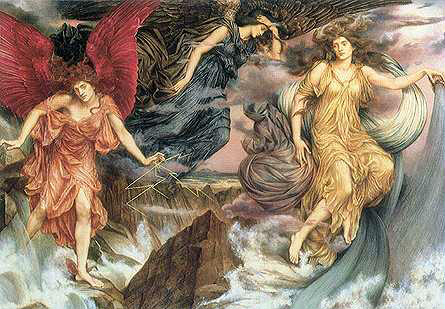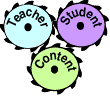Teaching and Learning:
Embracing a New Vision
by J'Anne
Ellsworth
Teaching
is a complex interplay of professional skills and personality traits rather
than a set of moves or maneuvers (Clark & Astuto, 1994; Hyman, 1997).
It is human interaction (Piaget, 1970; Schon, 1983; Borko, 1989), the
scientific, dramatic, and artistic, crafted and blended. Infinite potential
interactions occur from the number of student and teacher behaviors that
are potentiated.
This can
be multiplied exponentially by the underlying motives, developmental needs
and stages, the desires of each participant, the learning ability, the
interests and motivation (Tochon & Munby, 1993). It is daunting to pare
the possible exchanges and teacher responses that occur in the good classroom
into definable, observable, quantifiable events. (Peterson & Comeaux,
1989). In classrooms that are open and creative, learning interactions
may vary even more dramatically (Kirst, 1991a, 1991b; Wolf, et. al., 1991).
Attempts to define characteristics that set a dynamic world class teacher
apart from the typical teacher, and turn those assets and peculiarities
into reproducible behaviors that could be generated en mass, only partially
succeed (Swanson, et. al., 1990) for many of the most crucial elements
in a great teacher are elusive and idiosyncratic. Through history many
of those revered and beloved were teachers (Socrates, Christ, Buddha,
Mohammed, Copernicus).
Still, we
are not able to reproduce them, nor are teachers of such status commonly
recognized among us. In fact, frequently during their lives, our greatest
teachers were neither recognized as paragons nor valued highly for their
contributions. Often they were denigrated by their fellows and it was
as a result of their students and the "life" their teaching
took on, that the prowess of their teaching ability was perceived.

Authentic
Learning
In the same way that teaching is difficult to define, understanding and
recognizing learning can be as difficult to capture. Theories abound that
speak of cognition, meta-cognition, recall, perception, forgetfulness
(Siegler, 1991; Gagne, et. al, 1993; Driscoll, 1994). We seem hampered
by the need to name, capture and calculate this process and we are still
grappling with what is occurring in the classroom, the miracle of how
the mind accomplishes so much, why some people are unable or unwilling
to learn some of the material presented; the miracle of those who extend
learning and create novel and functional approaches that go beyond instruction.
In the past we returned to the developmental nature of conceptualization
(Piaget 1973, Vygotsky 1986), to social psychology (Allport, 1954; Erikson,
1963) and the study of modeling (Bandura, 1986) to capture learning and
teaching. We probed brain research, memory and retrieval, nonsense syllables,
visual, auditory and kinesthetic reception. We delved into encoding, the
long and working memories, training versus learning, and developed theories
of motivation (Stipeck, 1993).
Pressing
to produce a working model, we turned to multiple forms of intelligence
(Gardner, 1993), linked learning styles and Jungian personality theory
(Dunn & Dunn, 1978), evaluated and measured types of questioning (Bloom,
1968; Weigand, 1971), probed retrieval of facts and names, apparent learning
blocks or disabilities, tactile and intuitive ways of knowing.
Despite years of research, this quest for the working of the human mind
is very much an emerging frontier. We cannot assure that good teaching
necessarily leads to learning. There may be little direct relationship,
a curvilinear manifestation, or a coincidental rather than causal tie.
Each researcher has a perspective, and a predetermined way of defining
learning. What the researcher looks for is often what is observed. Using
this research model, we are still wrestling to define and measure intelligence,
grappling with definitions and measurement of creativity, humor, esteem.
Interestingly, most children love to learn, have a natural curiosity and
desire to question. By age five the child of normal intelligence has learned
a language, gained a personal sense of self, body control and sophisticated
utilization of large muscles, a vocabulary that includes hundreds or thousands
of words, social skills, coping mechanisms, and has a natural proclivity
to advance intellectually and fascination with inquiry. Undoubtedly learning
is occurring, yet this process primarily occurs in the absence of an organized
teaching setting. There is little competition, no formal evaluation or
grading system, few external rewards, seldom a curriculum or goals and
objectives. Capturing this excitement and sustaining the natural energy
and motivation could frame our future enterprise
Paradigm Shift
In the 1960's, Life magazine published articles about advances in scientific
knowledge. The DNA building blocks were one, the theory of Plate Tectonics
was another. They added such clarity to constructing the next steps in
science that we didn't miss the theories they replaced. We are at that
place in human science, but we seem on the cusp of visualizing a new paradigm
(Kuhn, 1962). The wish to reform is evident, the pain to motivate is certainly
in place. The need has provided impetus and energy and trials. To be true
to the scientific model, we must look beyond current methods. Exploring
human nature, understanding the dynamics of teaching and learning, working
beyond our current tools for quantifying human qualities may be intricate
work and call for different ways of observing, but we are at critical
mass and moving forward.
Building Blocks
We usually approach education as applying content to children, preparing
teachers to instruct and test acquisition of content. Revamping that perspective
and using an ecological vantage (Donaldson, 1985; Doyle, 1990) is a powerful
shift. When seen from a systemic perspective, teacher, student and content
are enmeshed and each adds dimension to education. Figure One represents
the concept of weighting each equally.

Figure One: The systemic nature of education
Adjusting the balance influences the student role most profoundly. Rogers
(1969) spoke to the importance of enhancing the student role and changed
the way he taught. Those visionary statements provide the foundation for
enhancing student and teacher roles.
|
IF
|
THEN
|
|
Each person knows self better than anyone else can --and is unique,
important, invaluable |
Trust
the learner, the individual, and encourage and honor personal evaluation
and insights |
|
Each person must believe in self and potential for growth and learning
to occur |
Facilitate healthy evaluation, affirmation and teach / model self
discipline and responsible self control |
|
Acceptance by an authority is a powerful motivator |
Show unconditional love of each student affirming efforts and strengthening
resolve rather than punishing error |
|
Desire to be healthy, to mature and to learn are always present |
Remain committed in actions and thoughts to the power of students
to strive for health, joy, knowing |
| Safety
is present, growth will be natural and ongoing |
Provide safety and structure for optimal environment |
|
Rejection stops growth an decreases ability to learn |
Build relationship that honors effort & trusts insights |
|
adapted
from C. Rogers 1969 |
Rogers implemented some of his ideas with graduate students and found
the work complex and many students resistant. Students did not immediately
embrace the opportunity to shoulder more educational responsibility. He
also found that empowerment of the student to make meaning of the educational
experiences spilled into changes in every other area. It changed the teaching
role, evaluation, impacted the learning community and changed the very
structure of education. The
same experience occurred for teachers who really implemented these ideas.
Johnson & Johnson (1994) experienced many of the same events as they implemented
cooperative learning. Reinsmith (1993) also found significant differences
in the learning environment and the role of student, content and evaluation
every time he altered the teaching role.
The child
is already a master at learning, but has little experience learning with
rigor and in the milieu of community. The youth is likely to have limited
ability to describe the self assessment he or she performs and modest
opportunities to verbalize personal feelings or share those insights with
others. To balance the roles and succeed, students need many essential
process skills and guided practice and support while learning and practicing
the new roles and responsibilities.

The teacher's
role also shifts. Teachers perform the multitude of roles of significance
-- mentor, counselor,
facilitator, educational
leader, team builder, builder of community, arbitrator and model (remember
to visit optional readings in this module to find 10 teaching roles).
Teachers continue to give energy and attention to interactions of teaching,
learning, and subject matter, the dynamics of process, becoming more adept
at using a range of personal powers, recognizing and extending unique
personalities, gauging student development and motivation. The energy
to teach, to share and transcend self is highly significant, as is a thorough
and deep understanding of the content being shared. The productive synergy
of traits, teachers and students, immersed in content continues to be
the teacher's domain. The following suggests some of the elements critical
to the more complex blend.
|
Strands
in a Multi-dimensional Education
|
| Teacher |
Student |
Content |
Assess
power and control dynamics
Utilize process skills to enhance shared responsibility
View role as multi-dimensional
Increase skills as facilitator
Validate student efforts and "Let go"
Prepare students to self evaluate and assist in self monitoring and
testing
Teach and utilize group processes |
Relish ownership of learning
Contract to accept responsibilities
Acquire content development skills
Set personal guidelines and self monitoring strategies
Develop self evaluation processes
Self monitor and record progress
Honor rigor and task completion
Work responsibly in community |
View as a continuum and provide range of lessons and sets of skills
daily
Develop assessments for student ownership
Teach process skills
Peer tutoring
Community building
Rigor and mastery valued |
 Step
One - Strengthening Student Skills Step
One - Strengthening Student Skills
The student role is the lynch pin in changing to a more dynamic educational
process. Teachers who work to change their own roles without altering
student perception and student abilities find pressure from students to
"get back in the box." There are several critical processes
and tools that facilitate student growth. The following instruments are
helpful tools for initiating and managing the learning curve for students.
They include: 1) learning contract, 2) student goal development, 3) student
self monitoring, 4) student self assessment,
5) conflict resolver.
The student contract is empowering for teachers and students. It
provides a clear structure, a base for understanding expectations and
a vocabulary to help students and teacher discuss behaviors and actions
productively and less defensively or angrily. The contract can be presented
by the teacher, discussed and altered by the class as a whole and then
can be sent home to parents so they are informed of expectations.
It
can serve as a mechanism for developing a behavior contract if some expectations
are beyond the reach of specific students. It can be individualized to
facilitate student development, serving as a safety net and a source of
inspiration and aspiration. For a student who is having difficulties,
self assessing person behavior can be empowering as the student works
to recognize and accept personal actions. Then the student can reflect
on the contract, and a meeting between teacher and student could ensue.
If improvement continues to lag, others in the school could work with
the student in establishing successful routines and it could become part
of a behavioral IEP.
This contract is geared for middle school and high school. The language
can be simplified for younger students and the process skills can serve
as a curriculum guide, with each area addressed and practiced in the lower
grades and implemented one skills at a time, adding new expectations as
the basic skills are in place.
Student Contract
|
|
I,_____________________________________
an Honor Student at _____________________ school,
verify by my signature that I understand for following:
- The
purpose of my being in the classroom
- My
duties as a student
- My
freedom as an Honor Student
- The
| |












